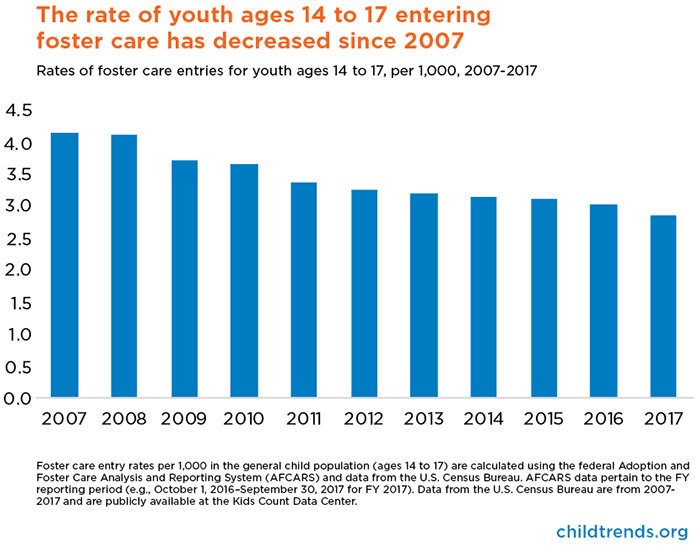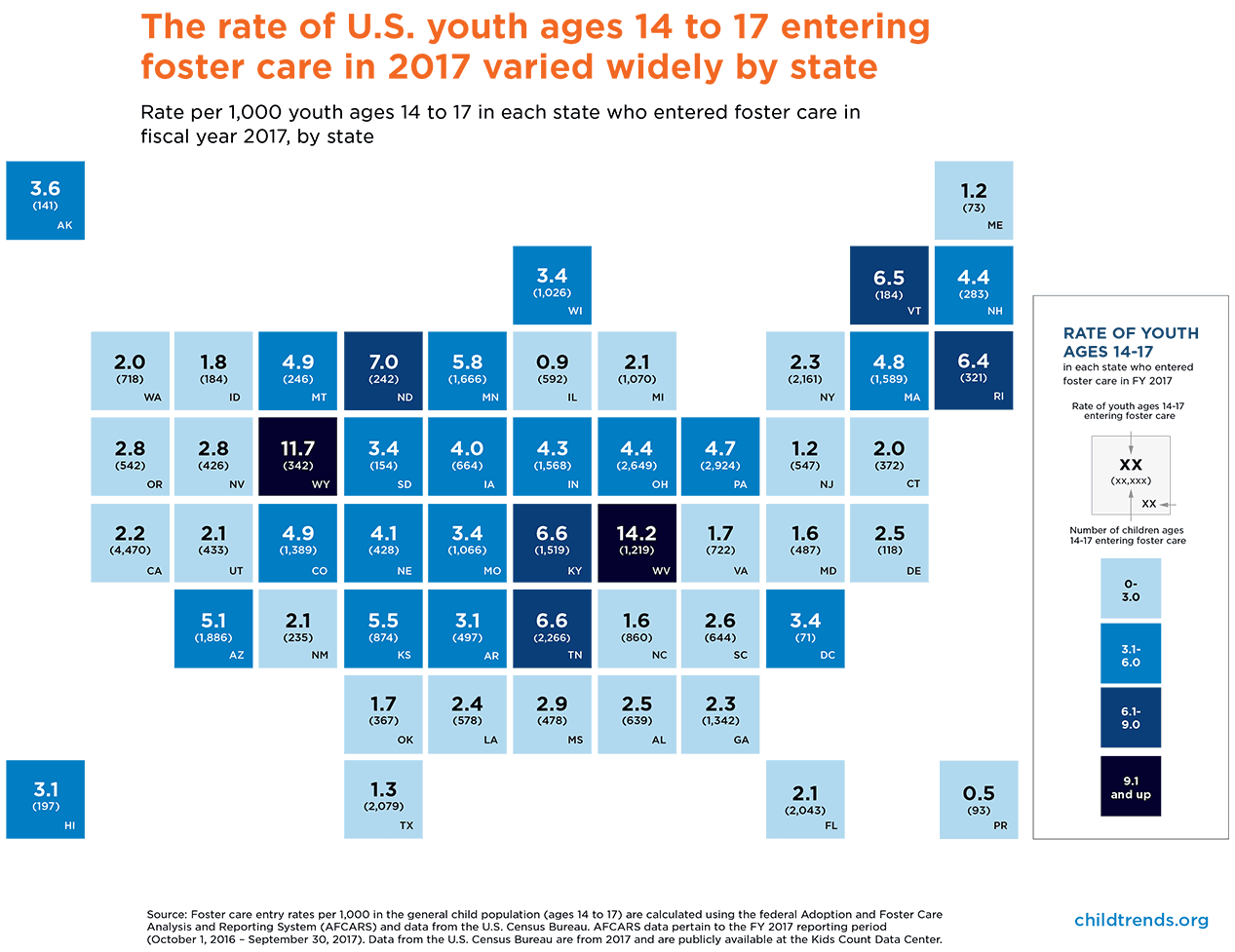Older youth in foster care need support to make a successful transition to adulthood
Nationally, over 47,600 older youth ages 14 to 17 entered foster care in federal fiscal year (FY) 2017—a rate of 2.8 per 1,000 youth in the general population. Although fewer older youth entered the child welfare system than in prior years, their experiences in foster care warrant attention because adolescence is a period of major brain development in which youth learn the decision-making and coping skills needed to become healthy and productive adults. Normal adolescent development involves increased risk-taking and self-discovery, but a lack of (or disconnection from) parents and supportive adults who could help them navigate this turbulent period may make it harder for older youth in care to successfully transition into adulthood.
Although the total number of children under age 18 in foster care has increased in recent years, the number of older youth in foster care has continuously dropped over the past decade. This trend is largely driven by a decrease in the number and rate of older youth coming into care (as opposed to an increase in the number or rate of older youth leaving care). Since FY 2007, there has been a 31 percent decrease in the rate of youth ages 14 to 17 entering foster care.

Child Trends’ analysis of FY 2017 data from the Adoption and Foster Care Reporting System (AFCARS) shows that states vary in the rates of foster care entry for youth ages 14 to 17, from 0.5 per 1,000 youth in Puerto Rico to 14.2 in West Virginia. The five states with the highest entry rates were West Virginia, Wyoming, North Dakota, Tennessee, and Kentucky. Puerto Rico, Illinois, Maine, New Jersey, and Texas had the lowest rates. Many factors likely contribute to this variation—for example, state variation in thresholds for removing a child from the home, in practices and policies around reporting maltreatment, or in policies around the use of voluntary out-of-home arrangements instead of placement in foster care.

Young people ages 14 to 17 were most commonly removed from their homes due to neglect (42%), which often accompanies other underlying factors such as substance abuse or parental mental health problems. The second-most common reason for removal was child behavior problems (38%), but this has become much less common since FY 2007 (dropping from 47 to 38 percent of removals). Parental drug abuse is the only removal reason, other than neglect, that has increased in both frequency and proportion among older youth—from 8 percent of cases in FY 2007 to 14 percent in FY 2017. Fortunately, the 2018 Family First Prevention Services Act presents opportunities to better support families experiencing parental drug abuse by making federal Title IV-E funding available for preventive services, including substance abuse services.
Older youth have vastly different experiences than other age groups once they enter foster care. They are more likely to experience placement instability, with 40 percent having four or more placements during their most recent stay in foster care, compared to only 15 percent of children under age 14. Increased placement instability can be explained in part by older youth’s longer stays in foster care: 30 percent of older youth had spent 2 years or more in care since their most recent removal, compared to 15 percent of children under age 14. Placement instability reduces the chances that young people will develop the permanent, supportive connections with caring adults that are needed during adolescence. It also can negatively affect behavioral health and education outcomes. In recent years, several pieces of legislation have aimed to improve school stability for young people in foster care, even in the face of residential placement instability, but practice and policy changes could also more directly target placement stability.
Experiences in care vary by child age, but so do permanency outcomes. Older youth who exited care during FY 2017 were more likely than children ages 13 and under to be reunified with their parent or primary caretaker (61% vs. 51%) or appointed a legal guardian (13% vs. 11%). However, they were far less likely than younger children in care to be adopted (10% vs. 29%). Youth who do not achieve permanency (reunification, adoption, or guardianship) before reaching the age at which foster care services are terminated in their state are considered to have “aged out.” Aging out is associated with negative outcomes—including early pregnancy, dropping out of high school, and homelessness—which are not only detrimental to the individual, but costly to society. These adverse outcomes and the associated financial burden on society could be avoided with improved policy and practice. Although many states offer extended supports beyond age 18 for youth who do not achieve permanency before age 18, many young people are not fully prepared for self-sufficiency until their mid-twenties, even when they have not experienced foster care. While extending foster care beyond age 18 represents significant progress, states should consider other policies—such as extending Medicaid to age 26 for former foster youth—that support the well-being of young adults even after they have exited foster care.
More research is needed to understand the driving forces and nuances related to older youth’s decreased entry rates. For example, a greater understanding of regional trends could inform cross-jurisdictional learning and spur further progress in regions that have not yet seen significant decreases in the entry rates of older youth. Although fewer older youth are entering foster care, practice and policy changes could improve the likelihood that they will successfully transition to adulthood. Available services must be strengthened and expanded to support older youth in foster care during this critical period of development and opportunity.
© Copyright 2024 ChildTrendsPrivacy Statement
Newsletter SignupLinkedInThreadsYouTube